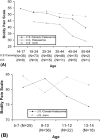Pain as an emergent issue in thalassemia
- PMID: 20232403
- PMCID: PMC5753761
- DOI: 10.1002/ajh.21670
Pain as an emergent issue in thalassemia
Abstract
Thalassemia is a congenital blood disorder often requiring chronic blood transfusions and iron chelation therapy [1,2]. While advances in treatment have resulted in increased life expectancy [3], extended life spans have exposed previously unidentified issues, including bodily pain. The aim of this study was to examine the prevalence, severity, predictors, and effects of pain in 265 adults/adolescents and 103 children with thalassemia. Overall, 69% of adults/adolescents reported bodily pain on the SF-36v2 health survey, with 28% reporting at least moderate pain. Parents reported pain in 56% of children using the PF-28 child health questionnaire, with only 11% reporting pain fairly often. There were no significant differences in pain in children with thalassemia compared with the general population. In adults/adolescents, pain increased significantly with age (P = 0.005), more so than in the general population. This study highlights the fact that children and young adults with thalassemia experience pain comparable to the general population, whereas older adults (aged 35+) experience greater pain. Our findings show that increased pain is associated with decreased quality of life and increased anxiety and depression.
Conflict of interest statement
Conflict of interest: Nothing to report.
Figures


Similar articles
-
Fracture patterns in thalassemia.Clin Orthop Relat Res. 1985 Jan-Feb;(192):132-6. Clin Orthop Relat Res. 1985. PMID: 3967413
-
Infection in thalassemia: a retrospective study of 1,018 patients with beta-thalassemia/Hb E disease.Birth Defects Orig Artic Ser. 1987;23(5A):505-11. Birth Defects Orig Artic Ser. 1987. PMID: 3689939 No abstract available.
-
Caring for adults with thalassemia in a pediatric world.Ann N Y Acad Sci. 2005;1054:266-72. doi: 10.1196/annals.1345.034. Ann N Y Acad Sci. 2005. PMID: 16339674 Review.
-
[On the association of hemoglobin C and thalassemia].Boll Soc Ital Biol Sper. 1971 Jan 30;47(2):38-41. Boll Soc Ital Biol Sper. 1971. PMID: 5088817 Italian. No abstract available.
-
[Hepatitis C in certain patient populations: children, patients with hemophilia and thalassemia, the hemodialyzed and kidney transplant recipients].Gastroenterol Clin Biol. 2002 Apr;26 Spec No 2:B91-104. Gastroenterol Clin Biol. 2002. PMID: 12180314 Review. French. No abstract available.
Cited by
-
Association of osteoporosis and sarcopenia with fracture risk in transfusion-dependent thalassemia.Sci Rep. 2023 Sep 29;13(1):16413. doi: 10.1038/s41598-023-43633-6. Sci Rep. 2023. PMID: 37775530 Free PMC article.
-
Understanding the Association between Red Blood Cell Transfusion Utilization and Humanistic and Economic Burden in Patients with β-Thalassemia from the Patients' Perspective.J Clin Med. 2023 Jan 4;12(2):414. doi: 10.3390/jcm12020414. J Clin Med. 2023. PMID: 36675342 Free PMC article.
-
Relationships among Physical Activity, Pain, and Bone Health in Youth and Adults with Thalassemia: An Observational Study.Thalass Rep. 2022 Sep;12(3):90-100. doi: 10.3390/thalassrep12030014. Epub 2022 Aug 11. Thalass Rep. 2022. PMID: 37139496 Free PMC article.
-
Cellular and biochemical heterogeneity contributes to the phenotypic diversity of transfusion-dependent β-thalassemia.Blood Adv. 2025 May 13;9(9):2091-2107. doi: 10.1182/bloodadvances.2024015232. Blood Adv. 2025. PMID: 39928952 Free PMC article.
-
Thalassemia-associated osteoporosis: a systematic review on treatment and brief overview of the disease.Osteoporos Int. 2016 Dec;27(12):3409-3425. doi: 10.1007/s00198-016-3719-z. Epub 2016 Aug 8. Osteoporos Int. 2016. PMID: 27503175
References
-
- Forget B, Cohen A. Thalassemia syndromes. In: Hoffman R, Benz E, Shattil S, editors. Hematology: Basic Principles and Practices. 4th. Philadelphia, PA: Elsevier, Churchill, Livingstone; 2005. pp. 557–598.
-
- Cohen AR, Galanello R, Pennell DJ, et al. Thalassemia. Hematology Am Soc Hematol Educ Program. 2004:14–34. - PubMed
-
- Desigan S, Hall-Craggs MA, Ho CP, et al. Degenerative disc disease as a cause of back pain in the thalassaemic population: A case-control study using MRI and plain radiographs. Skeletal Radiol. 2006;35:95–102. - PubMed
-
- Fucharoen S, Ketvichit P, Pootrakul P, et al. Clinical manifestation of beta-thalassemia/hemoglobin E disease. J Pediatr Hematol Oncol. 2000;22:552–557. - PubMed
Publication types
MeSH terms
Grants and funding
LinkOut - more resources
Full Text Sources
Medical
